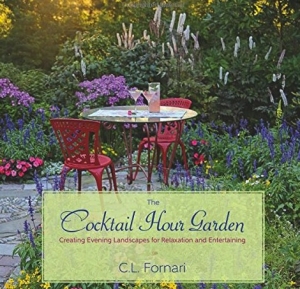The Night Garden Explained
By George Graine, Fairfax County Master Gardener
Flowers really do intoxicate. —Vita Sackville-West (1892–1962)
 If your lifestyle includes the occasional adult libation, then The Cocktail Hour Garden: Creating Evening Landscapes for Relaxation and Entertaining by C. L. Fornari (St. Lynn’s Press, 2016) is a worthwhile read for you. Lift a glass as you explore your own sanctuary during the “green hour.” Not familiar with the term? In French it’s l’heure verte, coined when absinthe drinking was the rage. For gardeners, this green hour can be time for relaxing and enjoying your handiwork.
If your lifestyle includes the occasional adult libation, then The Cocktail Hour Garden: Creating Evening Landscapes for Relaxation and Entertaining by C. L. Fornari (St. Lynn’s Press, 2016) is a worthwhile read for you. Lift a glass as you explore your own sanctuary during the “green hour.” Not familiar with the term? In French it’s l’heure verte, coined when absinthe drinking was the rage. For gardeners, this green hour can be time for relaxing and enjoying your handiwork.
This new book shows us how to enjoy many after-hours pleasures in the garden. Why stop after work at the neighborhood gin mill when you can relax at home surrounded by a verdant landscape that you’ve created or painstakingly enhanced? Your garden in the evening could become your own special, perhaps secret, place.
How does one create the ideal environment for the cocktail hour? It’s really simple! If you’ve read about how to construct a butterfly garden or a garden that attracts songbirds or hummingbirds, you can use a similar approach for a cocktail garden. In fact, a cocktail garden can be an addition to any existing wildlife garden. You just need to allocate space for this unique area meant for relaxation from the daily routine. As with any garden, you need precision: a plan that puts the right plant in the right place, so that your new plantings will become flavorful ingredients for cocktails and other beverages.
 Your cocktail garden in the evening is where your senses will come alive. You may hear the calls of frogs and the distinct sounds of crickets and cicadas. For other sounds, consider installing a water feature such as a stone vase fountain or multi-spillway bowl. Or add a wind chime or bells. Sounds will surely add to your enjoyment in this new garden. For more ambiance, consider adding a fire pit. This could be a simple DIY project, or you could purchase a ready-made fire pit that can be quickly put together. You may also want to add lighting, and this book offers suggestions.
Your cocktail garden in the evening is where your senses will come alive. You may hear the calls of frogs and the distinct sounds of crickets and cicadas. For other sounds, consider installing a water feature such as a stone vase fountain or multi-spillway bowl. Or add a wind chime or bells. Sounds will surely add to your enjoyment in this new garden. For more ambiance, consider adding a fire pit. This could be a simple DIY project, or you could purchase a ready-made fire pit that can be quickly put together. You may also want to add lighting, and this book offers suggestions.
Of course the author has a lot to say about plants. The book includes descriptions and color photos of shrubs, ornamental trees, vines, perennials and annuals. Unlike most encyclopedic plant books, its concise citations describe how plants can improve the cocktail garden. Think fragrant plants (not stinky ones) that you can smell close by and at a distance, but take care not to plant something where its fragrance will be too potent. Fragrance may come from foliage; the fig plant is one example. In selecting plants, remember that many fragrant ones are tropicals that need indoor shelter in winter. Think too about plants to touch, such as the wispy Mexican feather grass and corkscrew rush. Plants with unusual form, color or texture will also enhance the area.
Not slighting the sense of taste, the book includes recipes for drinks you won’t find at the local bar. These recipes, scattered through several chapters, use ingredients from your garden. The book’s final chapter contains many suggestions for using herbs and flowers in beverages, as well as how to make simple syrups and garnishes.
Ready to pursue this idea for a unique garden? Your time and effort will be rewarded with peaceful, relaxing evenings and pleasant memories.